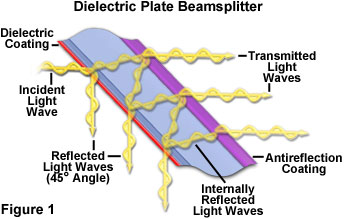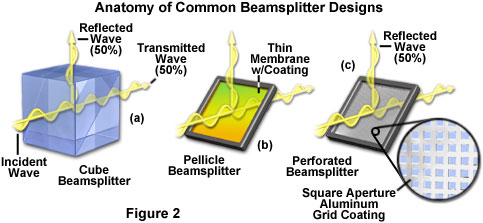Transmission and Reflection by Beamsplitters
Transmission and Reflection by Beamsplitters - Java Tutorial
A beamsplitter is a common optical component that partially transmits and partially reflects an incident light beam, usually in unequal proportions. In addition to the task of dividing light, beamsplitters can be employed to recombine two separate light beams or images into a single path. This interactive tutorial explores transmission and reflection of a light beam by three common beamsplitter designs.
The tutorial initializes with a cube beamsplitter positioned with an incident light wave impacting the planar front surface at a 90-degree angle (perpendicular) to the direction of propagation. In order to operate the tutorial, use the mouse cursor to translate the Transmission slider between a range of 25 and 75 percent. As the slider is moved from left to right, the amount of light transmitted through the beamsplitter is increased by the amount (percentage) displayed above the slider bar. The remaining percentage is reflected away from the beamsplitter at a 90-degree angle (upward in the tutorial). The type of beamsplitter presented in the tutorial can be changed from Cube to Pellicle or Perforated using the Beamsplitter Type radio button set.
The simplest configuration for a beamsplitter is an uncoated flat glass plate (such as a microscope slide), which has an average surface reflectance of about 4 percent. When placed at a 45-degree angle, the plate will transmit most of the light, but reflect a small amount at a 90-degree angle to the incident beam. Plate beamsplitters are, as the name implies, optical crown glass plates having a partially silvered coating designed to produce a desired transmission-to-reflection ratio. These ratios usually vary between 50:50 and 20:80, depending upon the application.

In general, a metallic or dielectric film is deposited on the first surface (facing the incident illumination) of the beamsplitter plate, while an antireflection coating is applied to the back (Figure 1). Antireflection coatings can be chosen to match the incident angle of light in order to minimize the amount of light reflected from the rear surface of the plate and reduce the possibility of ghost images. Typical antireflection coatings display only about 0.5 percent reflectivity at an incident angle of 45 degrees. Dielectric coatings must also be fine-tuned to produce the proper reflectance, polarization properties, and wavelength distribution at the angle for which the beamsplitter is designed. Because both dielectric and antireflection coatings have negligible absorbance in the visible light region (typically 0.5 percent for a 50/50 beamsplitter at 45 degrees), plate beamsplitters are ideal for a wide spectrum of applications.
One of the most serious consequences of using dielectric coatings for beamsplitter fabrication is the unequal transmission and reflection for p and s (parallel and perpendicular) polarization components of non-polarized incident light beams. As a result, some dielectric beamsplitters divide light unequally according to the polarization content, which can be undesirable in many applications. When using dielectric coatings, this artifact can often be circumvented by altering the polarization vector orientation of the incident light. In addition, the polarization effect can be reduced through the utilization of more sophisticated multi-layer thin-film dielectric coating designs, but often at the expense of other performance aspects.
Specialized non-polarizing beamsplitter coatings have been designed for use with polarized laser light where the incident radiation must maintain its polarization direction in both the transmitted and reflected beams. The coatings can effectively produce a clean 50/50 split of laser energy, regardless of the polarization state of the incident beam. As a side advantage, non-polarized light incident on these coatings has both the parallel and perpendicular components transmitted at almost equal ratios. Plate beamsplitters can also be designed to act as longpass and shortpass edge filters (positioned at a 45-degree angle) for applications requiring specific wavelength selection. In the case of longpass filters, longer wavelengths are transmitted and shorter wavelengths reflected at a 90-degree angle to the incident beam. Shortpass filters act in a reverse manner (transmit short wavelengths and reflect long wavelengths). Beamsplitters acting as edge filters are often referred to as dichroic or dichromatic mirrors.
Cube beamsplitters are fabricated by cementing together the hypotenuse faces of a matched pair of right-angle prisms with a partially reflecting film deposited onto the face of one the prisms (Figure 2(a)). All four faces of a cube beamsplitter are treated with an antireflection coating to minimize ghost images. For optimum results, the incident light beam should enter the beamsplitter through the prism that has been coated with reflecting film so that reflection occurs before the beam encounters the optical cement used to glue the cube together. Cube beamsplitters are more resistant to mechanical damage and deformation than plate beamsplitters, primarily because the reflective surface is protected by being sandwiched between the glass prisms.

Plate beamsplitters have some advantages when compared to cube beamsplitters, primarily the lack of an optical cement in the vicinity of the dielectric or metallic film, which can absorb light energy and reduce transmission. As a consequence, plate beamsplitters can withstand significantly higher levels of radiation without suffering damage. Single glass plates are also much smaller and lighter than a twin-prism cube, and can be more easily fitted into tight spaces for compact optical configurations.
Advanced coatings for cube beamsplitters include hybrid metal-dielectric films that combine the benefits of both materials. The result is a moderately efficient broadband beamsplitter that typically has absorption levels of about 10 percent with very little polarization sensitivity. Absorption losses are almost equally divided between transmitted and reflected beams, and polarization components lie within 5 to 10 percent of each other. Other broadband coatings have lower absorption characteristics, but are extremely sensitive to polarization. All-dielectric non-polarizing coatings are designed for high performance at specific wavelengths, usually for laser applications.
A third important class of beamsplitters is fabricated from a high tensile strength elastic membrane (such as nitrocellulose) stretched like a canvas over a black anodized flat metal frame. Termed a pellicle beamsplitter (Figure 2(b)), the membrane thickness ranges between 2 and 10 micrometers, so thin that it virtually eliminates ghost images. In addition, optical aberrations, such as chromatic, spherical, and astigmatism are reduced to a minimum when compared to plate and cube beamsplitters, dramatically expanding the possibilities of using convergent and divergent light. Uncoated pellicle membranes transmit about 92 percent of incident light throughout the visible and near-infrared spectral regions, but usually exhibit unacceptable absorbance in the ultraviolet. For most applications, pellicle membranes are coated with a thin dielectric film on the membrane side facing the incident light beam. These beamsplitters often fall victim to interference artifacts that result from the close proximity of the membrane surfaces, and they can also be subject to acoustical vibrations. Pellicle membrane surfaces should not be touched and can be cleaned only by a gentle flow of air.
Perforated beamsplitters (often termed polka-dot beamsplitters; see Figure 2(c)) are fabricated by coating an optical glass substrate with a thin layer of aluminum in fixed-size square apertures. The resulting surface has a "polka-dot" appearance, thus the name. By carefully adjusting aperture size, the ratio of coated to uncoated surface area in a perforated beamsplitter can be manipulated to equally split incident beams into transmitted and reflected components. Light waves encountering the uncoated surface pass through (losing a few percentage points to reflections from the glass) while those impacting the aluminum coating are reflected (usually at 45 degree angles). However, perforated beamsplitters demonstrate negligible sensitivity over a wide range of angles, and are useful for splitting light beams from divergent, broadband radiant sources such as a mercury arc or tungsten-halogen lamps. In addition, the grid pattern displays insignificant divergence of the transmitted beam due to diffraction and does not suffer from polarization artifacts. These filters are also useful with deuterium and xenon lamps, and find applications in monochromators, spectrophotometers, and other optical systems.
このページはお住まいの地域ではご覧いただくことはできません。